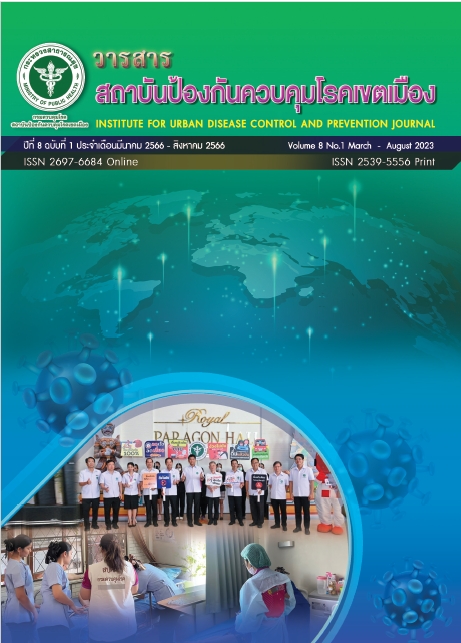ผลการติดตามดูแลสุขภาพทางไกลต่อคุณภาพชีวิตและความสามารถในการปฏิบัติกิจวัตรประจำวัน ของผู้ป่วยโรคหลอดเลือดสมอง โรงพยาบาลพหลพลพยุหเสนา จังหวัดกาญจนบุรี
Main Article Content
บทคัดย่อ
การวิจัยครั้งนี้เป็นการวิจัยเชิงกึ่งทดลองแบบสองกลุ่มวัดผลก่อนและหลังการทดลอง มีวัตถุประสงค์เพื่อศึกษาผลการติดตามดูแลสุขภาพทางไกลต่อคุณภาพชีวิตและการปฏิบัติกิจวัตรประจำวันของผู้ป่วยโรคหลอดเลือดสมองที่เข้ารับการรักษาที่โรงพยาบาลพหลพลพยุหเสนาและแพทย์อนุญาตให้กลับบ้านได้ระหว่างเดือนมกราคม- มีนาคม 2566 กลุ่มตัวอย่าง เลือกแบบเฉพาะเจาะจงกลุ่มควบคุม 30 คน และกลุ่มทดลอง 30 คน ผู้ป่วยทุกรายจะได้รับการประเมินความสามารถในการปฏิบัติกิจวัตรประจำวัน และคุณภาพชีวิต เป็นข้อมูลเบื้องต้นก่อนจำหน่ายกลับบ้าน (ครั้งที่ 1) โดยกลุ่มควบคุมได้รับการเยี่ยมบ้านตามปกติโดยทีมของโรงพยาบาลในสัปดาห์ที่ 2 และสัปดาห์ที่ 6 และได้รับการประเมินด้วยแบบสอบถามชุดเดิมอีกครั้งเมื่อเยี่ยมบ้านในสัปดาห์ที่ 6 ส่วนกลุ่มทดลองได้รับการเยี่ยมผ่านการโทรศัพท์ และระบบ video call ในสัปดาห์ ที่ 2, 3, 4, 6 และทำการประเมินด้วยแบบสอบถามชุดเดิมอีกครั้งในสัปดาห์ที่ 6 เช่นเดียวกัน วิเคราะห์ข้อมูลภายในกลุ่มด้วยสถิติบรรยาย และ Paired Sample T-Test ส่วนการวิเคราะห์ข้อมูลระหว่างกลุ่มใช้ Independent Sample T-Test
ผลการวิจัย พบว่า ความสามารถในการปฏิบัติกิจวัตรประจำวันในสัปดาห์ที่ 6 ของผู้ป่วยทั้งสองกลุ่ม มีคะแนนเฉลี่ยสูงกว่าก่อนทดลองอย่างมีนัยสำคัญทางสถิติ กลุ่มควบคุมมีคะแนนเฉลี่ยก่อนและหลังทดลอง เท่ากับ 54.33±15.18และ 86.00±15.66 (P<0.001) และกลุ่มทดลอง มีคะแนนเฉลี่ยก่อนและหลังทดลอง เท่ากับ 86.67+14 และ 96.00+7.24 (P<0.001) และคุณภาพชีวิตของผู้ป่วยทั้งสองกลุ่มมีคะแนนเฉลี่ยสูงกว่าก่อนทดลองอย่างมีนัยสำคัญทางสถิติ (กลุ่มควบคุม 56.46+12.15 และ77.96+11.38 ( p<0.001)และกลุ่มทดลอง 93.20+19.60 และ108.73+19.69(p<0.001) ตามลำดับ ส่วนความสามารถในการปฏิบัติกิจวัตรประจำวันและคุณภาพชีวิต เปรียบเทียบระหว่างกลุ่มควบคุมและกลุ่มทดลอง สัปดาห์ที่ 6พบว่าไม่แตกต่างกัน
สรุป การติดตามดูแลสุขภาพแบบทางไกลในผู้ป่วยโรคหลอดเลือดสมองของโรงพยาบาลพหลพลพยุหเสนาด้วยการ ติดตามให้ความรู้ ให้คำแนะนำ วางแผนให้การพยาบาล แก้ไขปัญหา เสริมกำลังใจ ให้คำปรึกษาอย่างต่อเนื่องเป็นระยะๆ พบว่าได้ผลลัพธ์เป็นที่น่าพอใจ ส่งผลให้ผู้ป่วยเกิดความตระหนัก มีกำลังใจและสามารถปฏิบัติกิจวัตรประจำวันได้ดีขึ้น เช่นเดียวกับการติดตามไปดูแลผู้ป่วยที่บ้าน ดังนั้น การนำแนวทางนี้ไปประยุกต์ใช้แทนการเยี่ยมที่บ้าน หรือใช้ร่วมกันอาจเป็นทางเลือกหนึ่งในอนาคตที่สะดวกและสอดคล้องกับสถานการณ์ ในปัจจุบัน ซึ่งหลายๆ โรงพยาบาลได้มีการใช้ระบบติดตามผู้ป่วยผ่าน telemedicine บ้างแล้ว
Article Details

อนุญาตภายใต้เงื่อนไข Creative Commons Attribution-NonCommercial-NoDerivatives 4.0 International License.
บทความที่พิมพ์ในวารสารสถาบันป้องกันควบคุมโรคเขตเมือง ถือว่าเป็นผลงานวิชาการ งานวิจัยและวิเคราะห์ ตลอดจนเป็นความเห็นส่วนตัวของผู้เขียนเอง ไม่ใช่ความเห็นของสถาบันป้องกันควบคุมโรคเขตเมือง หรือคณะบรรณาธิการแต่ประการใด ผู้เขียนจำต้องรับผิดชอบต่อบทความของตน
เอกสารอ้างอิง
พรพจน์ ประภาอนันตชัย, สมบัติ มุ่งทวีพงษา. กลุ่มอาการสมองขาดเลือด. วารสารประสาทวิทยาแห่งประเทศไทย.2557;30:24-34.
เพ็ญแข แดงสุวรรณ. Stroke: ฆาตกรเงียบ ระวังภัย ห่างไกล โรคหลอดเลือดสมอง. พิมพ์ครั้งที่ 2. กรุงเทพฯ: ใกล้หมอ; 2550.
World Health Organnization. Life course perspective on coronary heart disease stroke and diabetes Key issues and implications for policy and research summary report of a meeting of experts 2 - 4 May 2001. Geneva. Noncommunicable Disease and mental health cluster. 2001.
Summers D, Leonard A, Wentworth D, Saver JL, SimpsonJ, Spilker JA, et al. Comprehensive overview of nursing and interdisciplinary care of the acute ischemic stroke patient: A scientific statement from the American Heart Association. Stroke. 2009;40(8):2911-44.
นิจศรี ชาญณรงค์ (สุวรรณเวลา). การดูแลรักษาภาวะสมองขาดเลือดในระยะเฉียบพลัน. พิมพ์ครั้งที่ 3. กรุงเทพฯ: จุฬาลงกรณ์มหาวิทยาลัย; 2552.
วาสนา มูลฐี, สุปรีดา มั่นคง, ยุพาพิน ศิรโพธิ์งาม, สิริรัตน์ ลีลาจรัส. ผลของโปรแกรมการดูแลผู้ป่วยโรคหลอดเลือดสมองและญาติผู้ดูแล ระยะเปลี่ยนผ่านจากโรงพยาบาลสู่บ้านต่อความสามารถในการปฏิบัติ กิจวัตรประจำวันภาวะแทรกซ้อน และความพึงพอใจของผู้ป่วย. วารสารสภาการพยาบาล. 2559;31(1):95-110.
Orley J, Kuyken W. Quality of life assessment: international perspectives: proceedings of the joint meeting organized by the World Health Organization and the Foundation IPSEN in Paris, July 2-3 1993. Berlin: Springer-Verlag; 1994.
Pro Health Ware [Internet]. Vancouver: Pro Health Ware; 2018. Difference between Telemedicine and Telehealth. 2018 [Cited 2023 Feb 13]; [about 1 p.]. Available from: https://prohealthware.com/difference-between-telemedicine-and-telehealth/
Orem DE, Taylor SG, Renpenning KM. Nursing Concepts of Practice. 6th ed. St. Louis: Mosby; 2001.
ณาตยา โสนน้อย, อุษาวดี อัศดรวิเศษ, ประภาพรรณ ปุ่นอุดม, นงนุช เตชะวีรากร, เสรี สิงหถนัดกิจ. ผลของการบูรณา
การสหสาขาวิชาชีพติดตามผู้ป่วยที่ได้รับการผ่าตัดทำทางเบี่ยงหลอดเลือดหัวใจด้วยโปรแกรม Telehealth ต่อ
ความสามารถในการปฏิบัติกิจวัตรประจำวัน การกลับเข้านอนโรงพยาบาลซ้ำและความพึงพอใจของทีมสหสาขา
วิชาชีพ. วารสารพยาบาลโรคหัวใจและทรวงอก. 2565;33(2):84-100.
Mahoney FI, Barthel DW. Functional evaluation: The Barthel Index. Maryland state medical Journal. 1965;
:56-61.
กรมสุขภาพจิต [อินเทอร์เน็ต]. นนทบุรี: สำนักงาน; c2023. เครื่องมือชี้วัดคุณภาพชีวิตขององค์การอนามัยโลกชุดย่อ ฉบับภาษาไทย; 2566 [เข้าถึงเมื่อ 24 พ.ค. 2566]; [ประมาณ 1 น.]. เข้าถึงได้จาก https://dmh.go.th/test/whoqol/
สุรีรักษ์ มั่นคง, พิสมัย นพรัตน์, ณาตยา ปัญญาคม. ผลของโปรแกรมฟื้นฟูสมรรถภาพระยะกลางผู้ป่วยโรคหลอดเลือด
สมองในโรงพยาบาลท่าปลา. วารสารสุขภาพและสิ่งแวดล้อมศึกษา.2565;7(1):96-107.
บรรณฑวรรณ หิรัญเคราะห์, สุภาภรณ์ ด้วงแพง, ฉันทนา จันทวงศ์. ประสิทธิผลของโปรแกรมการพยาบาลในการฟื้นฟูสมรรถภาพที่บ้านสำหรับผู้ป่วยโรคหลอดเลือดสมองตีบต่อการทำหน้าที่ การรับรู้ภาวะสุขภาพและคุณภาพชีวิตที่เกี่ยวข้องกับสุขภาพ. วารสารวิจัยวิทยาศาสตร์สุขภาพ. 2560;11(2):28-37.
แจ่มจันทร์ ประทีปมโนวงศ์. ความสัมพันธ์ระหว่างความสามารถในการปฏิบัติกิจวัตรประจำวัน พฤติกรรมการออก กำลังกายและคุณภาพชีวิตผู้สูงอายุโรคหลอดเลือดหัวใจ. วารสารคณะพยาบาลศาสตร์มหาวิทยาลัยบูรพา. 2562;27(4):66-76.
ณัฐภัสสร เดิมขุนทด, รัชนีวรรณ ขวัญเจริญ, ชาญวัฒน์ ชวนตันติกมล, พิชญ์ พหลภาคย์, สว่างจิต สุรอมรกูล. ผลการติดตามสุขภาพทางไกลต่อการควบคุมระดับน้ำตาลในเลือดและความสม่ำเสมอในการรับประทานยาในผู้ป่วยเบาหวานชนิดที่ 2 ที่ควบคุมไม่ดี. วชิรเวชสารและวารสารเวชศาสตร์เขตเมือง. 2564;65(ฉบับเพิ่มเติม):575-90.
ณัฐนันท์ อุสายพันธ์, โสภิดา สัณฐมิตร, นิภา เทพสิมานนท์. การพัฒนาระบบบริการด้านการฟื้นฟูสมรรถภาพผู้ป่วยโรคหลอดเลือดสมองจังหวัดสุราษฎร์ธานี.วารสารวิชาการแพทย์เขต 11. 2559;3(1):85-93.
นวลขนิษฐ์ ลิขิตลือชา, ทิพย์สุดา ลาภภักดี, พัชรีย์ กลัดจอมพงษ์, บรรณาธิการ. การพยาบาลผู้ป่วยที่บ้าน.กรุงเทพมหานคร: โรงพิมพ์ชุมนุมการเกษตรแห่งประเทศไทย; 2556.
นพวรรณ ผ่องใส. ผลของการดูแลตามระยะเปลี่ยนผ่านต่อความสามารถในการปฏิบัติกิจวัตรประจำวันของผู้ป่วยโรคหลอดเลือดสมอง [ปริญญานิพนธ์ปริญญาพยาบาลศาสตรมหาบัณฑิต]. เชียงใหม่: มหาวิทยาลัยเชียงใหม่; 2552.


